Holiday World – Santa Claus, Indiana
It can be tough being a middle child. Such is the case for the Legend, always being upstaged by its older and younger siblings the Raven and the Voyage, at least when it comes to where enthusiasts tend to throw most of their love for Holiday World’s coasters. There could be any number of reasons for this, such as an inferior layout, not quite as much airtime as its siblings, moments of weak pacing, a less effective use of terrain, frequently the roughest tracking of the three, repressed mother issues…
 Let’s look at a couple of these issues one-by-one to see if the problem can be identified (sorry, won’t have time to touch on the last one). When it comes to layouts, the Legend is indisputably the most unfocused of the three, and has long been regarded as a chaotic, frequently meandering, laterals-focused contrast to the simple, poetic airtime-laden beauty that is the Raven. Simply compare the Legend’s layout to that of the Raven to see how different they are:
Let’s look at a couple of these issues one-by-one to see if the problem can be identified (sorry, won’t have time to touch on the last one). When it comes to layouts, the Legend is indisputably the most unfocused of the three, and has long been regarded as a chaotic, frequently meandering, laterals-focused contrast to the simple, poetic airtime-laden beauty that is the Raven. Simply compare the Legend’s layout to that of the Raven to see how different they are:
Cresting the lift hill, there’s a quick right-hand turn before diving straight down a sharp plunge that’s world-renown for offering supreme airtime in the back rows. Greeting us at the bottom is a tunnel that heightens the impact of the ride’s maximum speed. Out of the tunnel is a slightly bent hill that almost sets us up for some sort of cockeyed out-and-back routine. However it is only followed up by a singular rise before transitioning into a signature, right-hand turnaround maneuver. At first tracing back alongside the initial outward bound track with a second, smaller hill, the ride seems to let up pace for just a moment at the apex of the next hill. No wonder why, as it sets up the coaster’s centerpiece moment: the fifth drop, a deep, dangerous dive that surprises by going down further along the ground than it was on the way up. Pulling hard out of this drop we are greeted with a fast ground-level s-curve that switches to a stretch of prebank that empties us into an long right turn that makes up the majority of this second half of the ride. After clearing this long finale the layout finds its way back to the station.
I think the above clearly demonstrates the Legend to be the inferior coaster, although I can be more certain when I figure out which of the two rides I just described…
 I remember way back during the winter of the Legend’s construction, and Will Koch was basking in the glow of the Raven’s success over winning the Golden Ticket for best wooden coaster in the country, he speculated during a helicopter fly-over of the construction site that their chances of taking the #1 spot with the Legend were about fifty-fifty. That was ten years ago
I remember way back during the winter of the Legend’s construction, and Will Koch was basking in the glow of the Raven’s success over winning the Golden Ticket for best wooden coaster in the country, he speculated during a helicopter fly-over of the construction site that their chances of taking the #1 spot with the Legend were about fifty-fifty. That was ten years ago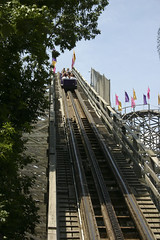 and I doubt I’ll be able to find that broadcasting again (many thanks if someone out there can!), but I remembered that one line because he seemed so confident in it and then it never came close to true. While certainly a great ride that would even see the light of top ten lists on multiple occasions, no matter what poll results you look at the Legend is always found somewhere beneath the Raven’s name, even if they happened to occupy the #1 and #2 positions. I always dismissed Koch’s original confidence in his ride as simply not having a firm understanding of what exactly made the Raven so great, choosing to string together an arbitrary assortment of popular wooden coaster parts, each suggested from their enthusiast feedback campaign, on a ride twice as expensive and calling that an improvement. After looking at their layouts a second time I now realize he knew exactly what the Raven’s success formula was and tried to carbon-copy that on a more impressive scale as closely as possible. Where else did the Legend go wrong?
and I doubt I’ll be able to find that broadcasting again (many thanks if someone out there can!), but I remembered that one line because he seemed so confident in it and then it never came close to true. While certainly a great ride that would even see the light of top ten lists on multiple occasions, no matter what poll results you look at the Legend is always found somewhere beneath the Raven’s name, even if they happened to occupy the #1 and #2 positions. I always dismissed Koch’s original confidence in his ride as simply not having a firm understanding of what exactly made the Raven so great, choosing to string together an arbitrary assortment of popular wooden coaster parts, each suggested from their enthusiast feedback campaign, on a ride twice as expensive and calling that an improvement. After looking at their layouts a second time I now realize he knew exactly what the Raven’s success formula was and tried to carbon-copy that on a more impressive scale as closely as possible. Where else did the Legend go wrong?
Honestly, when I first visited Holiday World in 2000 the Legend was far and away my favorite ride compared to the Raven. So much so that the late night ride in the rain we had at the end of the day caused it to become my number one wood for a year (displacing even my home state favorite of Shivering Timbers) until I got an even more epic night ride on the Beast the following year. So what happened in the intervening time? The replacement of the single Gerstlauer train with two PTCs certainly didn’t harm the ride quality, although the alternations done to the station to accommodate the change in blocking I don’t think were a positive one; it used to really look and feel like a schoolhouse that Ichabod Crane once taught in, now it’s just this sort of long 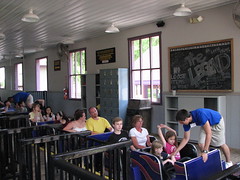 claustrophobic structure with metal roofing, no school bell and only a chalkboard to indicate the school theme which I swear hasn’t been touched in years (fairly sure in 2009 it was the same drawing I saw back in 2005 or at least ’06… not saying that as a complaint but out of amazement that no one ever once accidentally brushed their sleeve against it). One of the more critical factors might be a change in surroundings. The Legend used to be ‘out in the woods’
claustrophobic structure with metal roofing, no school bell and only a chalkboard to indicate the school theme which I swear hasn’t been touched in years (fairly sure in 2009 it was the same drawing I saw back in 2005 or at least ’06… not saying that as a complaint but out of amazement that no one ever once accidentally brushed their sleeve against it). One of the more critical factors might be a change in surroundings. The Legend used to be ‘out in the woods’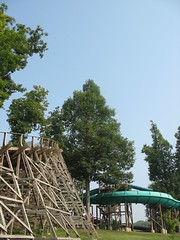 like the Raven, now, while it’s set out along the woods, the waterpark heavily encroaches on the initial out-and-back run, the spotlights for some reason still on full power even though Splashin’ Safari had long since closed for the night. The second half of the ride never quite gets there as a terrain ride either, any elevation differences having a minimal effect on the ride progression and are completely unnoticeable by riders onboard; the more compact nature of the layout with taller structures meant more trees had to be cleared around the lift and helix so it’s always been pretty exposed after the partially subterranean tunnel as well with no attempts to replant trees in this area really evident. The crossovers with the helix and lift also dilute the terrain coaster experience, as does the fact that the finale isn’t set deep in the woods as the Raven’s is but rather in the infield between the lift/Frightful Falls and the ride’s station and queue area.
like the Raven, now, while it’s set out along the woods, the waterpark heavily encroaches on the initial out-and-back run, the spotlights for some reason still on full power even though Splashin’ Safari had long since closed for the night. The second half of the ride never quite gets there as a terrain ride either, any elevation differences having a minimal effect on the ride progression and are completely unnoticeable by riders onboard; the more compact nature of the layout with taller structures meant more trees had to be cleared around the lift and helix so it’s always been pretty exposed after the partially subterranean tunnel as well with no attempts to replant trees in this area really evident. The crossovers with the helix and lift also dilute the terrain coaster experience, as does the fact that the finale isn’t set deep in the woods as the Raven’s is but rather in the infield between the lift/Frightful Falls and the ride’s station and queue area.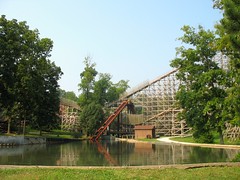
This is starting to sound petty; the Legend still has much better setting than any of Cedar Fair’s recent attempts at preserving the rugged woodlands around their terrain coasters (ahemProwler ahemDiamondbackahem). What about the coaster itself? Probably the most obvious distinction is that, while the layout features a strikingly similar series of elements, the Legend’s were designed in such a way that highlights the coaster as being a lateral-g-force-centric ride, while the Raven is all about airtime. One only needs to look at the Mitch Hawker Coaster Poll to see hard evidence that enthusiasts prefer both floater and ejector air over laterals. But even then I’m dubious that the Legend really falls behind in this category. I only count three, maybe four moments of air on the Raven (first drop, second hill, sort of the third, then the fifth drop) while Legend matches that 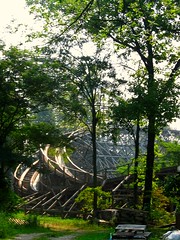 count fairly well (first drop, shorter waterslide hill, fifth drop), it’s just that the Legend also has a longer total track, the rest of it dedicated to hard laterals.
count fairly well (first drop, shorter waterslide hill, fifth drop), it’s just that the Legend also has a longer total track, the rest of it dedicated to hard laterals.
And while we’re talking about laterals, I need to point out that these aren’t just your everyday, run-of-the-mill laterals on a wooden coaster. The Legend is probably the preeminent coaster in the nation for aggressive, sustained laterals (yes, even above the Voyage’s strong turnaround and return run). Look at the banking, especially in the helix. Half the time it isn’t there at all. While the Voyage might feature equally strong lateral forces in places, Gravity Group knows how to adjust for these and the constant computer-controlled shifting of the banking pitch can spoil the illusion that the ride is genuinely out-of-control, while on the Legend it becomes obvious that CCI didn’t feel like overworking their track bender and so you truly don’t know if the next part of the four corners finale will be dangerously underbanked in a way that could threaten your safety (don’t worry, it’s not… though you will definitely feel it the morning after a marathon Legend riding session).
Roughness is another potential factor, although I don’t like to use roughness too much as a case against a coaster since that’s generally only a chronic condition compared to acute factors such as layout deficiencies. Nevertheless, reading park reports from Holiday World over the years the Legend is the one coaster of the three in which on more than one occasion I’ve heard the R-word thrown out there. I didn’t have a problem at all with roughness in 2009, it ran exactly like it should have; 2006 was a bit slow and shuffling, but not rough; 2005 was fast, a bit more rough, but after a few rides I adjusted to it and didn’t mind at all by the end of the day. Perhaps roughness can describe a few individual biases that result in some reduced poll rankings, but it shouldn’t be a universal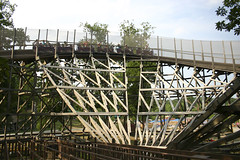 factor especially for people that have had the chance to visit the park on more than one occasion.
factor especially for people that have had the chance to visit the park on more than one occasion.
 The last explanation for why the Legend seems to not quite live up to the standard of the Raven might be a bit more esoteric but might come the closest. My thesis in my Raven analysis was that its success was primarily defined by the exceptional use of progression, creating a logical flow between the
The last explanation for why the Legend seems to not quite live up to the standard of the Raven might be a bit more esoteric but might come the closest. My thesis in my Raven analysis was that its success was primarily defined by the exceptional use of progression, creating a logical flow between the 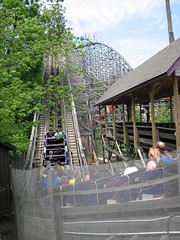 classical wooden coaster first half and sustained speed terrain flight in the second. While the sequencing of the elements is similar between the two rides, and if you are to measure the absolute quantity of forces and other positive dimensions of both rides the Legend will probably outweigh Raven, there are also moments along the Legend in which bad pacing does a disservice to any potential sense of progression, and as a result the ride feels less disciplined and with more filler than the tightly-wound, potent Raven. That is to say, the Raven and even the Voyage have the ability to exceed the sum total of their parts, while the Legend is only to equal to the sum its parts. Thankfully, it has a lot of really good parts.
classical wooden coaster first half and sustained speed terrain flight in the second. While the sequencing of the elements is similar between the two rides, and if you are to measure the absolute quantity of forces and other positive dimensions of both rides the Legend will probably outweigh Raven, there are also moments along the Legend in which bad pacing does a disservice to any potential sense of progression, and as a result the ride feels less disciplined and with more filler than the tightly-wound, potent Raven. That is to say, the Raven and even the Voyage have the ability to exceed the sum total of their parts, while the Legend is only to equal to the sum its parts. Thankfully, it has a lot of really good parts.
Deciding where to sit? Because the Legend focuses so much on laterals it doesn’t matter as much, front row, back row, middle, they’re all quite good. However first drop connoisseurs should find a lot to savor in the back of the train. I also found that sitting on the right side of the train produces a slightly more intense riding experience, there only being a seat divider instead of a full-sized, padded wall to lean against during the spiral drop, helix and the four corners finale. We round the bend after departing the station and climb the 99 ft. tall lift. This lift structure is actually quite massive, it’s hard to get a proper perspective on it from inside the park; wide enough that the lateral braces come together
quite good. However first drop connoisseurs should find a lot to savor in the back of the train. I also found that sitting on the right side of the train produces a slightly more intense riding experience, there only being a seat divider instead of a full-sized, padded wall to lean against during the spiral drop, helix and the four corners finale. We round the bend after departing the station and climb the 99 ft. tall lift. This lift structure is actually quite massive, it’s hard to get a proper perspective on it from inside the park; wide enough that the lateral braces come together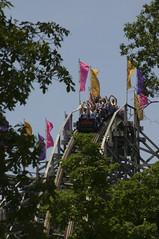 to form a vertical column of wood in the center of the elevated turnaround at the top. It’s a tight turn, though, even offering a small taste of the laterals (it might even tip outward a little bit) that are to
to form a vertical column of wood in the center of the elevated turnaround at the top. It’s a tight turn, though, even offering a small taste of the laterals (it might even tip outward a little bit) that are to become a very big theme with this coaster. A werewolf howl and voice calling “Don’t look back!” reminds us of the supposed story behind this ride (with the Voyage in place I now just think of these rides as ‘wooden coasters’ irrespective of what themed section of the park they’re in); these can be heard from all over the park, and as soon as the sound cuts, there’s a moment of complete silence as the train hangs over the sharp edge looking down the 113 ft. first drop.
become a very big theme with this coaster. A werewolf howl and voice calling “Don’t look back!” reminds us of the supposed story behind this ride (with the Voyage in place I now just think of these rides as ‘wooden coasters’ irrespective of what themed section of the park they’re in); these can be heard from all over the park, and as soon as the sound cuts, there’s a moment of complete silence as the train hangs over the sharp edge looking down the 113 ft. first drop.
Tremendous pull-over and power. If there’s one area that the Legend beats both its younger and older siblings it’s the first drop, and given the reputation each of their initial plummets have that’s no small praise. We don’t get as long of a downward ramp to sustain the negative-g’s as the curved pullout hits somewhat early, but I don’t mind too much because the speed is so rapidly accelerating and feeling the laterals grow stronger as we approach the tunnel is intimidating enough by itself. The train hits the tunnel. Back in 2000 I remember feeling like as soon as we entered the darkness the roar of the trains and wind caught in the tunnel wanted to rip my face off; now it’s just a tunnel but still a very impressive addition. Some people might chide the fact that Holiday World feels it necessary
If there’s one area that the Legend beats both its younger and older siblings it’s the first drop, and given the reputation each of their initial plummets have that’s no small praise. We don’t get as long of a downward ramp to sustain the negative-g’s as the curved pullout hits somewhat early, but I don’t mind too much because the speed is so rapidly accelerating and feeling the laterals grow stronger as we approach the tunnel is intimidating enough by itself. The train hits the tunnel. Back in 2000 I remember feeling like as soon as we entered the darkness the roar of the trains and wind caught in the tunnel wanted to rip my face off; now it’s just a tunnel but still a very impressive addition. Some people might chide the fact that Holiday World feels it necessary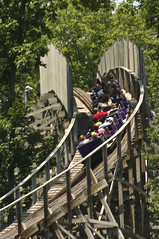 to add multiple tunnels to all their rides, but I say keep it up (well, except for the tunnels on Wildebeest which is already a partially enclosed slide, I’m still scratching my head over the logic behind that one).
to add multiple tunnels to all their rides, but I say keep it up (well, except for the tunnels on Wildebeest which is already a partially enclosed slide, I’m still scratching my head over the logic behind that one).
Out of the tunnel the first element is a very long, extended hill. No airtime to be found here, however not only is the speed sustained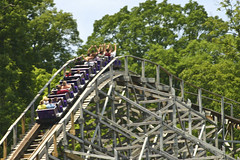 really well over the entire arc but there’s a jazzy back-and-forth movement, first to the left on the way up, then to the right over the top, and then mirroring itself with another jog to the left on the pullout. Strong laterals on each of these turns, I always forget that this is just a single element and not two or three separate maneuvers.
really well over the entire arc but there’s a jazzy back-and-forth movement, first to the left on the way up, then to the right over the top, and then mirroring itself with another jog to the left on the pullout. Strong laterals on each of these turns, I always forget that this is just a single element and not two or three separate maneuvers.
The train pulls high up the next hill, pausing for a moment at the top as we eyeball a 77 ft. spiral drop ahead of us.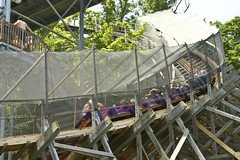 Back on my night ride in 2000, I remember getting to the top of this hill and finding that the entire vista ahead of me was just a pure black canvas; my only night ride since then had the waterpark flood lights all turned on. The laterals stay fairly consistent around this bend, strong, but they will get stronger. One thing that interests me about this curve is the non-constant radius is one of the few examples by CCI where the overhead footer arrangement was not aligned as either a perfect line or circle. The dive underneath Zinga also required that a tunnel of netting be installed, which helps enhance the speed and visuals along this stretch.
Back on my night ride in 2000, I remember getting to the top of this hill and finding that the entire vista ahead of me was just a pure black canvas; my only night ride since then had the waterpark flood lights all turned on. The laterals stay fairly consistent around this bend, strong, but they will get stronger. One thing that interests me about this curve is the non-constant radius is one of the few examples by CCI where the overhead footer arrangement was not aligned as either a perfect line or circle. The dive underneath Zinga also required that a tunnel of netting be installed, which helps enhance the speed and visuals along this stretch.
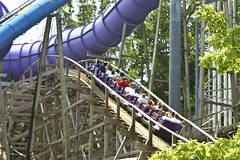 Remember how I said I actually thought the Legend was not that far behind the Raven as far as quantity and quality of airtime is concerned? We’ve already covered the similar first drops, but this next hill that threatens to skid our knuckles across the underside of Zoombabwe might be where you can find the best sustained air in the entire park… yes, even despite the Voyage being next door! The crest is mostly circular which means there’s a strong pop just after the pull upwards, and this mildly forceful ejector is sustained over the entire hill for a couple of seconds as the train keeps its speed up nicely. Another straight bottoming out and the train pulls up again into another hill as if anticipating a second pop of airtime.
Remember how I said I actually thought the Legend was not that far behind the Raven as far as quantity and quality of airtime is concerned? We’ve already covered the similar first drops, but this next hill that threatens to skid our knuckles across the underside of Zoombabwe might be where you can find the best sustained air in the entire park… yes, even despite the Voyage being next door! The crest is mostly circular which means there’s a strong pop just after the pull upwards, and this mildly forceful ejector is sustained over the entire hill for a couple of seconds as the train keeps its speed up nicely. Another straight bottoming out and the train pulls up again into another hill as if anticipating a second pop of airtime.
Here’s where the progression structure starts to fail. Not that there really was any clear progression to be found in these beginning elements, but they’re all fun just as elements by themselves and the same is true of the Raven; the contrast only becomes evident later in the ride after the midcourse drop. This fifth hill was clearly an attempt to emulate the fifth drop on the Raven, instead of settling for another strong airtime pop, it eschews any immediate forces to instead climb as high as it can so it can set up a similar big midcourse drop, even using a partially underground tunnel on the other end as a way to further exaggerate the height difference. The problem is both that it wasn’t set-up properly to allow the mind to register it as a “big midcourse moment after a lull”, the pacing was going strong all the way up to this point, and then suddenly it stopped as it had to make it up farther than it had momentum for. The result is a hill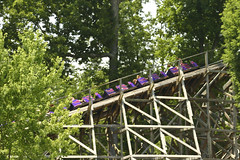 that feels forced, and somewhat of a dud. There’s a bit of air in the back rows on the way down, but that brings up another problem with this hill, it’s only 64 foot deep… admittedly slightly larger than the Raven’s fifth drop, however this is after a 77 ft. spiral drop and 113 ft. first drop. Unlike the Raven that uses the terrain to surprise us with a huge fall after only a small upward rise, there isn’t any terrain advantage, so we only fall as far as we already expected. Rather than act as a midpoint, it’s just a missed opportunity and the ride has to work hard to make up for the lost pace.
that feels forced, and somewhat of a dud. There’s a bit of air in the back rows on the way down, but that brings up another problem with this hill, it’s only 64 foot deep… admittedly slightly larger than the Raven’s fifth drop, however this is after a 77 ft. spiral drop and 113 ft. first drop. Unlike the Raven that uses the terrain to surprise us with a huge fall after only a small upward rise, there isn’t any terrain advantage, so we only fall as far as we already expected. Rather than act as a midpoint, it’s just a missed opportunity and the ride has to work hard to make up for the lost pace.
The second tunnel is quick, and on the way out we start a similar left-to-right s curve that the Raven has after its big drop, only this one has much longer timing between transitions with some sustained strong laterals in either direction. The banking for has long prebanks that can make this stretch of track feel rather uneasy; going into the second part of the s-bend you slowly tip to the left from the prebank before being thrown hard to the right, and then you suddenly fall back out of it when it passes the curve and you slowly tip back to level. I won’t try to figure out where this fits within the context of the overall progression since the sequencing of elements has already been fairly haphazard, but this is probably the Legend at its most out-of-control thus far.
only this one has much longer timing between transitions with some sustained strong laterals in either direction. The banking for has long prebanks that can make this stretch of track feel rather uneasy; going into the second part of the s-bend you slowly tip to the left from the prebank before being thrown hard to the right, and then you suddenly fall back out of it when it passes the curve and you slowly tip back to level. I won’t try to figure out where this fits within the context of the overall progression since the sequencing of elements has already been fairly haphazard, but this is probably the Legend at its most out-of-control thus far.
We slowly tip sideways again with another long prebank leading us under a layer of helix as we 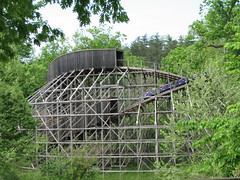 anticipate entering both the third tunnel and the clockwise double helix. This maneuver was directly inspired by the Beast’s finale, and while it might come close as far as lateral intensity, these helices are really two different animals. The Beast sustains huge laterals and speed in the tunnels, only breathing for air in the middle open-air section, while the Legend’s is more of a carousel, alternating between fast and slow, coming and going through tunnels without any real plan or order to mayhem, nothing but constantly sustained laterals that slowly increase over the entire duration of the helix, the second layer not even banked at all. Also, the Beast uses it’s helix as a finale after a huge setup, while the Legend’s just sort of ‘happens’ after an upward climb, and ends up working as a great centerpiece to the second half of the layout.
anticipate entering both the third tunnel and the clockwise double helix. This maneuver was directly inspired by the Beast’s finale, and while it might come close as far as lateral intensity, these helices are really two different animals. The Beast sustains huge laterals and speed in the tunnels, only breathing for air in the middle open-air section, while the Legend’s is more of a carousel, alternating between fast and slow, coming and going through tunnels without any real plan or order to mayhem, nothing but constantly sustained laterals that slowly increase over the entire duration of the helix, the second layer not even banked at all. Also, the Beast uses it’s helix as a finale after a huge setup, while the Legend’s just sort of ‘happens’ after an upward climb, and ends up working as a great centerpiece to the second half of the layout.
After the helix, the pace once again lets up, a very wide hill that turns us slightly to the left to line up with a shallow dip through the lift support structure. Many critics of the Legend will likely cite that the layout is meandering, and they most likely have this stretch of track in mind as a particular. I must concur. After the helix it always feels like the ride momentarily runs out of ideas and makes us wait as it tries to figure out how to get back to the station and end things. A couple years ago I would have said that it never figures out that problem and just randomly meanders back to the station without much of a goal other than to throw in several more odd moments of laterals. However, today I now recognize what comes after this let-down in pace as one of my other favorite things about the Legend: the four corners finale.
However, today I now recognize what comes after this let-down in pace as one of my other favorite things about the Legend: the four corners finale.
So this is basically a long lead-in into one sharp turn sequenced after another each sharp and boxy enough that the term ‘corner’ seems highly appropriate. How are the laterals? Hang on tight, is my reply. The effect of these final corners is a syncopated stop-start intensity structure, where 2/3 of the time is spent just sitting and waiting to anticipate the next turn, which occupies the remaining 1/3 of the time, which is a second or two of total lateral g-force brutality, repeated over three times. It’s quirky, intense and unlike any effect I’ve ever had on another wooden coaster. The last of the corners holds the moment out a bit more with a 180 degree turnaround instead of just a 90 degree switch. It’s too bad it can’t take place in the thick woods as the Raven’s finale does because this is a uniquely innovative way to end the ride.
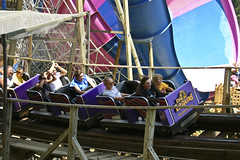 Back to the original question: where did the Legend go wrong? I realize now that this question was definitely framed in the wrong way. The Legend is one of CCI’s top rated wooden coasters, near the same leagues as coasters such as Shivering Timbers, Boulder Dash and Tremors. If there is a question along those lines
Back to the original question: where did the Legend go wrong? I realize now that this question was definitely framed in the wrong way. The Legend is one of CCI’s top rated wooden coasters, near the same leagues as coasters such as Shivering Timbers, Boulder Dash and Tremors. If there is a question along those lines that can be asked, it should be “what doesn’t the Legend do perfectly right?” I guess the layout is still a bit unfocused, never clear if it tries to be a terrain, twister or airtime ride, without an obvious progression and a couple of moments of bad pacing… plus the night rides aren’t at quite the same level as Raven and Voyage. However, based on my experiences from my last visit, where I got no less than twenty rides each on Holiday World’s wooden coasters, while the Voyage may have been the most ambitious and the Raven made the most of its short track length, I truthfully found the Legend to be the most consistently satisfying of all three, the eclectic mix of elements such as the first drop, waterslide hill, helix and four corners always promising another fun ride, one in which I could stop trying to analyze every moment and just enjoy the damn coaster for what it is. And isn’t that what it’s really all about?
that can be asked, it should be “what doesn’t the Legend do perfectly right?” I guess the layout is still a bit unfocused, never clear if it tries to be a terrain, twister or airtime ride, without an obvious progression and a couple of moments of bad pacing… plus the night rides aren’t at quite the same level as Raven and Voyage. However, based on my experiences from my last visit, where I got no less than twenty rides each on Holiday World’s wooden coasters, while the Voyage may have been the most ambitious and the Raven made the most of its short track length, I truthfully found the Legend to be the most consistently satisfying of all three, the eclectic mix of elements such as the first drop, waterslide hill, helix and four corners always promising another fun ride, one in which I could stop trying to analyze every moment and just enjoy the damn coaster for what it is. And isn’t that what it’s really all about?
(Additional photo credits to Anthony Harrison and Freddie Ross. Used with permission.)
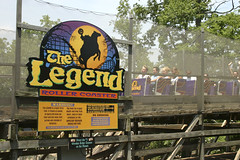

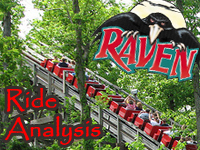
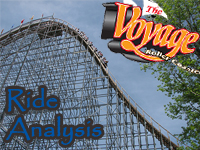
Further discussion can be found on rec.roller-coaster
Another great analysis. I had to watch a POV just now to refresh my memory. I’ve been on this only a handful of times and that was just last season. I can see how this ride has to be in top form for it to work. My favorite thing about CCI’s is that organic feel of train and track like hand in glove. I think it’s a combo of classic wooden coaster principles with proper modern acceleration in design and maneuvers. It’s as if the track itself is somehow propelling as well as guiding the train through elements. This was very apparent on my rides on The Legend last season. I don’t think GG was able to retain this.. I’m not sure if it is just the steel superstructers. Anyhow, great analysis. I never gave much thought to this design because all in all I just found the ride so satisfying like you said at the end. If I were to be analytical though I would have to say as an enthusiast I did wish there was a bit more madness to the helix since it seems to invoke the craziness of The Beast but doesn’t summon it. It’s more like a carousel I guess, again, like you said.
I will be sure to read “The Voyage” and “The Raven” next when I get some time.
I completely agree about the feel of CCI’s, the “organic feel of train and track like hand in glove” I think is one of the best analogies I’ve heard to describe them. Legend was definitely CCI at their most aggressive and (I don’t know what the best word is) …earthy? While most other CCIs have slowed down due to roughness or just having the time pass them by, Legend still runs like it always was supposed to. It was popular when it first opened but it eventually faded, however I would not be surprised to see a resurgence in popularity in the next decade as it becomes one of the last good examples of being a genuinely out-of-control styled wooden coaster, built during that brief window of time when designers were able to be much more daring than the classicists and using complex layouts but still far from having every bent and ledger fine-tuned by an advanced computer program.
I completely agree. Cyclops and Zeus are also good examples of that hand in glove thing… though short and quirky layouts they deliver consistently.
I’m headed out to Holiday World for my first time next month, and The Legend is actually the one I’ve been looking forward to the most. I think it has something to do with the fact that, until reading your long and in-depth analysis, I had never really heard much about it. Everything is always about the Voyage or the Raven, the later of which I have heard many a coaster connoisseur call “overrated.” The Legend looks like a fun ride from the videos I’ve seen of it. While the Voyage looks like it will most certainly live up to the hype, I have my doubts with the Raven. There’s virtually no real hype for The Legend though, so that actually has me excited about it, because I don’t really know what to expect, other than a well maintained woodie. (I’ve never heard Holiday World’s coaster in the CCI candidates for demolishon catagory, so I know they take care of their rides)